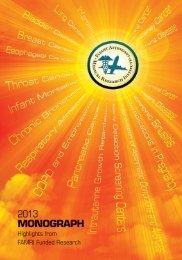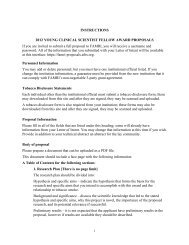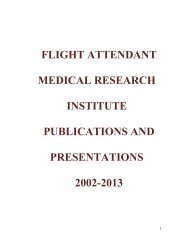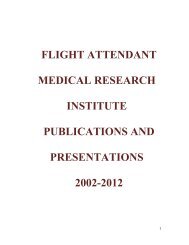MISSION
2009 compendium of FAMRI-supported research - Flight Attendant ...
2009 compendium of FAMRI-supported research - Flight Attendant ...
You also want an ePaper? Increase the reach of your titles
YUMPU automatically turns print PDFs into web optimized ePapers that Google loves.
EVALUATING THE CHARACTERISTICS THAT INFLUENCE PERSUASIVENESS OF SECOND HAND TOBACCO SMOKE<br />
ADVERTISEMENTS<br />
Maansi Bansal-Travers, PhD; Roswell Park Cancer Center; YCSA 2008<br />
The Task Force on Community Preventive Services at the CDC recently called for more research to<br />
establish the features of advertising that increase support for adoption of smoke-free standards, especially in<br />
homes and cars. There are not any studies that have explicitly attempted to evaluate the effectiveness of<br />
different SHS advertisements targeting parents to motivate adoption of such standards for their home and<br />
car. Dr. Bansal-Travers’ study will fill this knowledge gap. This experimental study will examine how<br />
different characteristics of anti-SHS television advertisements such as the execution features of the<br />
advertisement (i.e., use of testimonials versus. negative visceral images), its focus (i.e., health effects versus<br />
social norms), and intended target audience (i.e., parents versus general audience) interact to affect<br />
comprehension, appraisal, recall, engagement with the advertising, and intention to adopt smoke-free<br />
standards in households and cars where one or both parents smoke. It is hypothesized that advertisements,<br />
which utilize personal testimonials and dramatize the health consequences of SHS exposure, and which<br />
specifically target parents will be better recalled, appraised more highly, and rated higher in terms of<br />
increasing support for smoke-free home and car standards compared to advertisements that do not share<br />
these characteristics. Another question addressed by this project is the extent to which the findings can be<br />
generalized across different cities and countries. This study will employ a sample of 40 advertisements<br />
designed to communicate risks of SHS exposure, collected by the Office on Smoking and Health at the<br />
CDC. Advertisements will be shown to parents in Buffalo, NY, and Columbia, SC, to see if parents in<br />
different cities respond in the same way to anti-SHS messages and appeals. Ten Spanish-language<br />
advertisements will also be tested in a pilot test in Mexico City to examine how these methods translate in<br />
different countries and languages. Analyses will include ranking persuasiveness of different ads, what themes<br />
and characteristics predict higher rates of parent comprehension and overall appraisal, and at follow-up, what<br />
ads persuade higher rates of recall, discussion, and intention to adopt smoke-free home and car standards.<br />
DISEASE PREVENTION<br />
COMPLETED RESEARCH<br />
DEVELOPMENT AND IMPLEMENTATION OF SMOKING RESTRICTIONS<br />
Lisa A. Bero, PhD; University of California, San Francisco; CIA 2003<br />
Dr. Bero developed a history for initiatives banning smoking on airlines by conducting a systematic review<br />
to identify all governmental standards that restricted or banned smoking on airlines in the United States and<br />
abroad. The PI determined the following timelines: 1) all U.S. federal regulatory proceedings pertaining to<br />
smoking restrictions on passenger aircraft and their outcomes from 1969 to 1985; 2) all federal attempts to<br />
restrict airline smoking from 1969 through 2000; 3) the adoption of smoking restrictions on aircraft placed<br />
in the context of other important events; 4) international initiatives restricting airline smoking. The PI<br />
performed an assessment of the relative roles of research evidence and other factors restricting smoking on<br />
airlines. Using the 1987 legislation banning smoking on flights of 2 hours or less and the extension of that<br />
ban to include most domestic flights was adopted in 1989. All available legislative debates, hearings,<br />
committees, and conference reports on each of the two initiatives were compiled. All of the key factors that<br />
contributed to the enactment of the airline smoking bans in 1987 and 1989 were outlined. The extensive<br />
timelines that were developed and thorough identification of tobacco industry activities over the 30 year<br />
period provided an understanding of the scientific, social, and political context in which these two initiatives<br />
were enacted. Taken together, this information makes it possible to discern the relative importance of the<br />
various factors that went into the enactment of the smoking bans.<br />
FAMRI Supported Publications<br />
Baba A, Cook D, McGarity T, Bero LA. Legislating “sound science” regulation: Role of the tobacco<br />
industry. Am J Public Health 2005;95:s20-s27.<br />
Dalton S, Dunsby J, Bero LA. Narrative skills in the shaping of workplace smoking restrictions legislation<br />
Presented at the Annual Meeting of the American Sociological Association, 2004.<br />
Jewell C, Rose D, Bero LA. Public participation in the regulatory process: The case of California’s<br />
ergonomics rule Presented at the Annual Meeting of the Law and Society Association, 2005.<br />
Lopipero P, Bero LA. Tobacco interests or the public interest: 20 years of industry strategies to undermine<br />
airline smoking restrictions. Tob Control 2006;15:323-332.<br />
P A G E 1 7 5







